Piscines pour chiens
Une option rafraîchissante en été

LES PISCINES POUR CHIENS SONT-ELLES RECOMMANDÉES ?
Temps de lecture approximatif : 8 minutes
Tout comme nous, avec l’arrivée des fortes chaleurs, les chiens peuvent se sentir très échauffés et avoir du mal à supporter la chaleur. Vous remarquerez peut-être que votre compagnon est moins vif, moins motivé et moins enclin à jouer. Avez-vous déjà pensé à lui offrir une piscine pour chien ? Il existe sur le marché de nombreux types de piscines spécialement conçues pour eux, fabriquées dans des matériaux plus résistants et disponibles en différentes tailles.
Mais, est-ce qu'il est vraiment bon pour un chien de se baigner dans une piscine ? La réponse est oui (bien qu’il faille prendre certaines précautions), car cela lui permet de réguler sa température corporelle et de se détendre en se rafraîchissant lorsque la chaleur devient intense.
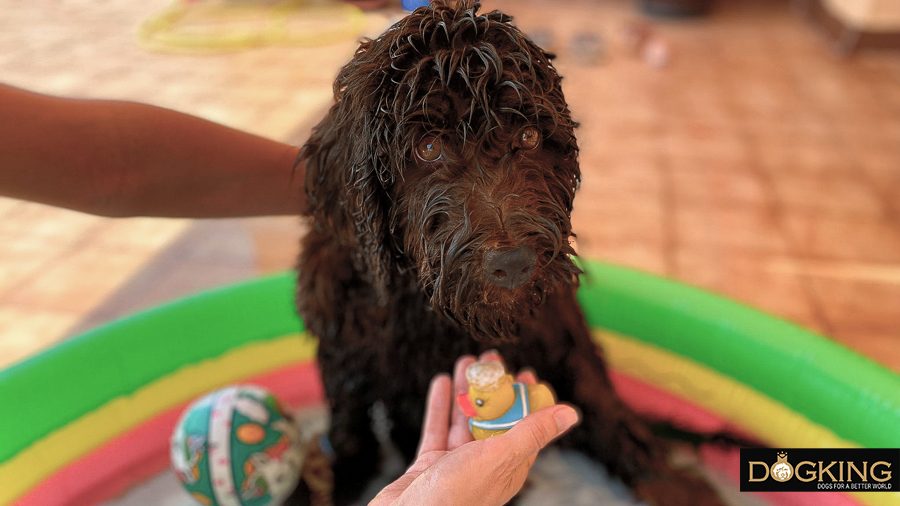
Table de matières
1- Comment choisir une bonne piscine pour mon chien ?
2- Mon chien peut-il se baigner dans ma piscine ?
3- Les piscines publiques pour chiens
4- Que faire si mon chien a peur de l'eau ?
Comment choisir une bonne piscine pour mon chien ?
De nombreuses personnes commettent l'erreur d'acheter des piscines conventionnelles pour leurs chiens. Le résultat est que le matériau, trop fragile pour les dents et les ongles de ces animaux, ne dure que quelques jours avant de se casser, ce qui en fait un gaspillage d'argent tout à fait déconseillé. Les piscines pour chiens, en revanche, sont généralement fabriquées en PVC, un matériau très résistant qui convient à nos animaux de compagnie. Lors de l'achat d'une piscine pour chiens, veillez également à ce qu'elle réponde aux exigences suivantes et tenez compte de nos recommandations.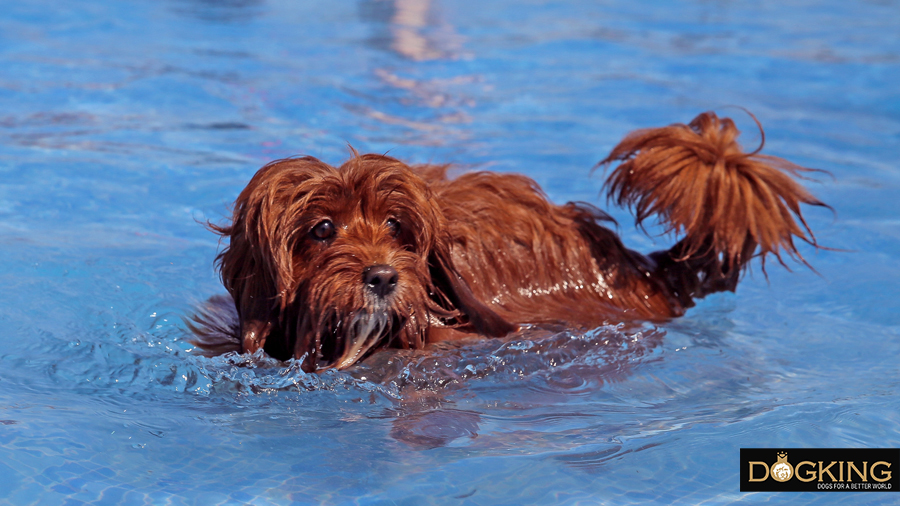
Qui puisse se plier
Bien qu'il existe des piscines gonflables pour chiens qui promettent d'être plus durables que les traditionnelles piscines à pataugeoires, les piscines pliantes constituent une option bien plus durable. Leur matériau est généralement plus solide et plus rigide et leur fond est doté d'un traitement antidérapant pour une meilleure prise en main. En outre, bien qu'elles ne soient pas aussi légères que les piscines gonflables, vous pouvez facilement les plier pour les ranger à la fin de l'été. En revanche, la plupart des piscines gonflables pour chiens sont en fait des piscines pour enfants qui se cassent rapidement en raison du frottement des ongles et des dents de l'animal.
Qui ait une taille appropriée
La piscine idéale pour votre chien est celle qui est suffisamment grande pour qu'il puisse s'allonger, s'étirer, se retourner et se sentir libre et détendu. Toutefois, si votre chien est de petite ou moyenne taille, faites attention à la hauteur de la piscine, car votre animal doit pouvoir atteindre le bord pour sortir de l'eau quand il le souhaite. Même si votre compagnon à quatre pattes sait nager, les dimensions de la piscine doivent lui permettre d'entrer et de sortir facilement de l'eau lorsqu'il en a besoin.
Qui soit facile à installer
Lorsque l'été arrive et que la chaleur nous ôte l'envie d'effectuer des tâches lourdes, si vous ne voulez pas que la piscine de votre chien reste ouverte dans un coin du garage, privilégiez les modèles d'installation simples. Soyez bien informé sur le processus d'installation afin que votre chien puisse profiter de ses baignades agréables sans complications.
Qui dispose d'un drain pour le vidage
Cela semble évident, mais toutes les piscines pour chiens ne sont pas équipées d'une bonde de vidange. Si vous avez un petit chien et que vous utilisez une piscine plus petite, ce n'est pas très grave car il ne vous faudra pas trop de temps pour la vider (vous pouvez rapidement jeter l'eau dans la baignoire), mais si la piscine de votre chien est plus grande, il ne sera pas très amusant de vider l'eau à l'aide d'un seau. En revanche, une piscine équipée d'une bonde se vide rapidement, ce qui vous permet de passer du temps à nettoyer la piscine jusqu'à sa prochaine utilisation.
Le meilleur endroit pour placer la piscine pour chiens
Une fois que vous avez acheté la piscine idéale pour votre chien, vous devez choisir un bon endroit pour la placer. Nous vous recommandons un endroit à l'ombre, car s'il passe trop d'heures au soleil, votre animal pourrait souffrir de coups de soleil ou d'insolation. Choisissez une surface plane, sans surplomb, ni rocher, ni pente. Certaines personnes ayant des chiens de petite ou moyenne taille préfèrent improviser des piscines maison avec des bassins, mais ceux-ci doivent être placés dans les endroits les plus frais et les plus aérés possibles, car ils ne sont généralement pas résistants à la chaleur et peuvent devenir trop chauds, ce qui fait que l'eau se réchauffe très rapidement.
Rendez-le amusant !
Si vous voulez que votre animal n'oublie jamais ses moments de baignade estivale dans la piscine, n'oubliez pas de mettre ses jouets sous-marins préférés dans l'eau. Vous pouvez également opter pour des piscines à jets, qui rendront l'heure du bain beaucoup plus amusante.
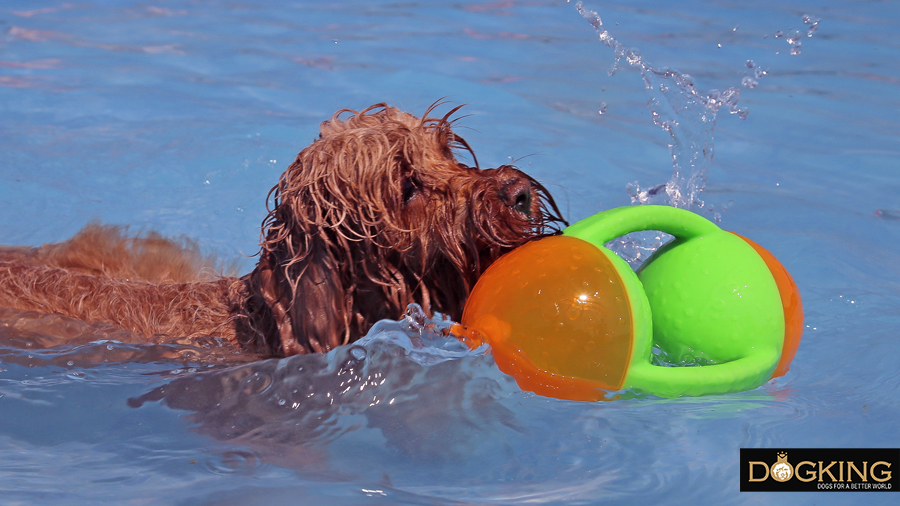
Précautions à prendre pour baigner votre chien dans la piscine
En tant que membre de votre famille, votre chien mérite lui aussi de profiter d'une nage relaxante et amusante dans votre piscine. Toutefois, gardez à l'esprit les recommandations suivantes pour éviter tout problème :
- Protégez votre chien du soleil. Placez la piscine dans un endroit à l'ombre ou, si ce n'est pas possible, utilisez une crème solaire pour chiens et répétez l'application toutes les quelques minutes, conformément à l'étiquette. Même dans ce cas, il n'est pas conseillé à un chien de passer trop de temps au soleil, il est donc plus sûr de combiner de courtes baignades avec des périodes de repos.
- Brossez-le avant et après l'avoir baigné. Le brossage avant l'entrée dans l'eau permet d'éliminer l'excès de poils, la poussière et la saleté, ce qui permet de garder la piscine propre plus longtemps. Pour les chiens à poils longs, comme le Australian Cobberdog, il est nécessaire de les brosser avant le bain, afin de démêler les nœuds éventuels, car les poils mouillés resserrent les nœuds et, au moment de les sécher, le problème est encore plus grand.
- Rincez ses poils. Après le bain, vous devez rincer votre chien à l'eau claire pour enlever la poussière, les feuilles ou l'herbe qui ont pu tomber dans la piscine pendant le bain. L'eau des piscines pour chiens est stagnante et, bien qu'elle doive être maintenue propre et changée périodiquement, il est conseillé de prendre une douche fraîche pour terminer le bain de votre chien.
- Séchez soigneusement votre animal. Lorsque vous sortez de l'eau, séchez les oreilles de votre animal, ainsi que ses coussinets et la zone située sous sa queue, à l'aide d'une serviette ou d'un chiffon sec. La peau mouillée est beaucoup plus sujette aux infections. Séchez-la au sèche-cheveux à la maison afin que les parties profondes du pelage ne soient pas mouillées.
- Vaccination et vermifugation à jour. L'eau est un milieu dans lequel certaines bactéries prolifèrent plus facilement, il est donc essentiel que votre chien soit protégé pour éviter les infections. En effet, les chiots ne doivent pas se baigner dans une piscine publique s'ils n'ont pas reçu les vaccins obligatoires, car ils sont plus vulnérables à ces maladies.
- Ne le nourrissez pas avant ou après. Pour éviter les chocs thermiques avec la digestion, il est préférable de ne pas nourrir votre chien une heure avant ou une heure après son bain de piscine. Bien entendu, ne le nourrissez pas non plus dans l'eau.
Mon chien peut-il se baigner dans ma piscine ?
Si vous disposez d'une piscine sur votre terrain ou dans votre jardin, vous pouvez laisser votre chien s'y baigner, mais toujours sous votre surveillance. En effet, votre chien ne doit pas avoir accès à la piscine si vous n'êtes pas avec lui, veillez donc à la protéger par une clôture si nécessaire. Même si votre chien sait nager, il est dangereux qu'il soit seul dans l'eau, car il pourrait avoir un problème comme une crampe musculaire, une piqûre de guêpe avec une réaction allergique, un coup de soleil, etc.
Veillez également à ce que votre chien ne boive pas l'eau de votre piscine, car le chlore et les produits chimiques qu'elle contient pour rester propre peuvent provoquer un empoisonnement, avec des symptômes tels que des vomissements ou des diarrhées. Si votre animal a bu de l'eau de votre piscine et que vous pensez qu'il a été intoxiqué par le chlore, emmenez-le immédiatement chez un vétérinaire. En outre, un contact prolongé avec le chlore peut provoquer une irritation de la peau et des yeux, ainsi qu'un dessèchement du pelage. Après que votre chien se soit baigné avec vous dans votre piscine, n'oubliez pas de lui donner une douche avec de l'eau propre et du savon pour éliminer tout résidu sur son pelage et sa peau.
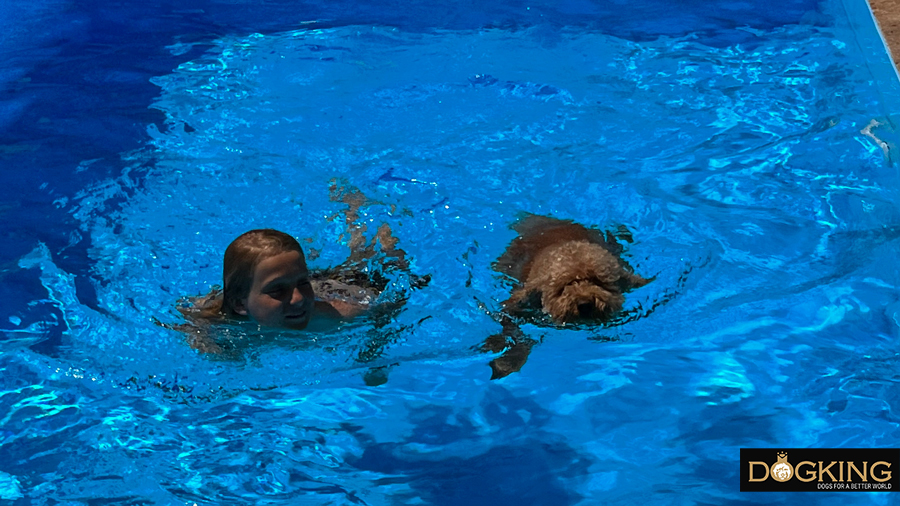
Les piscines publiques pour chiens
Finalement, les piscines publiques pour chiens constituent une excellente option pour permettre à votre chien de profiter d'une bonne baignade estivale. Il existe de plus en plus de piscines de ce type, avec des toboggans et des profondeurs différentes. Dans ces installations aquatiques canines, vous devez respecter certaines règles, telles que le type de chiens autorisés dans chaque zone, la vaccination et la vermifugation des animaux pour pouvoir y accéder, évitant ainsi la prolifération d'infections.
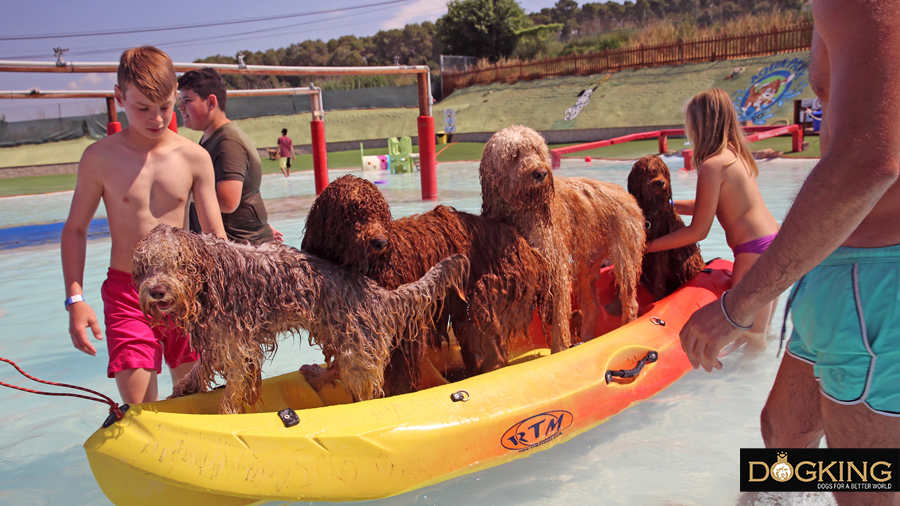
Que faire si mon chien a peur de l'eau ?
La plupart des chiens savent nager instinctivement, mais toutes les races n'ont pas la même facilité. Quelle que soit la chaleur de votre animal et même si vous pensez qu'il profiterait d'une baignade dans la piscine, vous ne devez jamais le forcer à entrer dans l'eau s'il a peur, ce qui est plus fréquent dans les grandes piscines pour humains. Veillez à ce que l'exposition à la piscine soit progressive. Vous pouvez jouer avec ses jouets préférés dans l'eau et le laisser vous observer. Vous pouvez entrer dans la piscine et interagir avec lui de l'intérieur et, progressivement, vous éveillerez la curiosité de votre chien. Au bout d'un certain temps, il devrait normalement entrer dans l'eau de lui-même, mais si vous ne constatez pas de progrès ou d'intérêt de sa part, ne le forcez en aucun cas.
Chaque chien a sa propre personnalité et ses propres préférences. L'idée est que vous trouviez un moyen de vous rafraîchir et de profiter de l'été ensemble, qu'il s'agisse d'une bonne baignade dans la piscine, de quelques courses au bord de la mer ou de quelques jets d'eau dans le jardin.